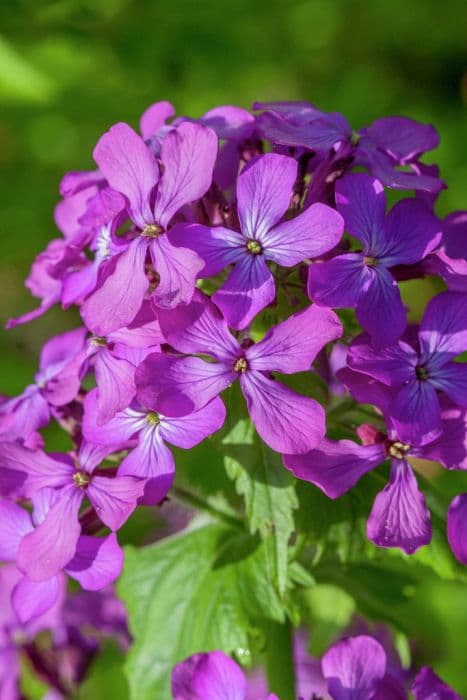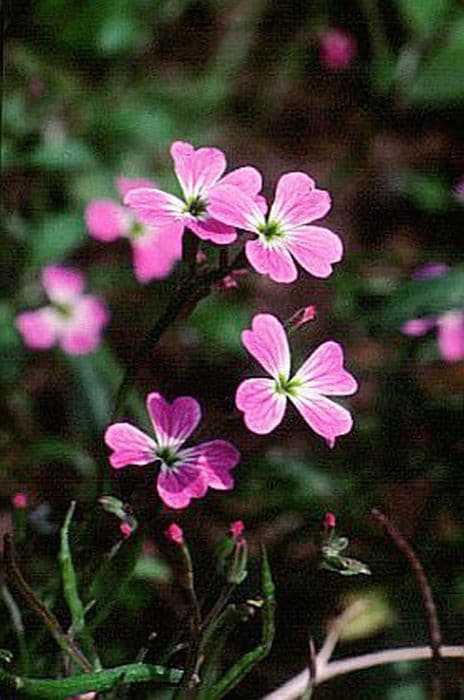Arugula Eruca vesicaria



ABOUT
Arugula is a leafy green plant that typically grows to a height of 1 to 2 feet, with individual leaves measuring around 2 to 4 inches in length. It has a cluster of elongated, lobed leaves that form a rosette shape.
The plant features slender stems and may produce small white flowers when it reaches maturity. Arugula is known for its distinctive peppery flavor and is commonly used in culinary applications, such as salads, sandwiches, and pesto.
About this plant
 Names
NamesFamily
Brassicaceae
Synonyms
Arugula, Garden rocket, Jamba, Salad rocket, Edible rocket, Eruca, Roquette, Rucola, Ruchetta, Rucoli, Rugula, Colewort
Common names
Eruca sativa, Rucola silvatica
 Toxicity
ToxicityTo humans
Arugula is generally safe for human consumption and is not considered toxic. However, like any food, individual sensitivities or allergies may vary, and excessive consumption of arugula could cause digestive discomfort in some individuals.
To pets
In terms of animals, arugula is generally safe for most domestic pets when consumed in moderation. However, it is always important to check with a veterinarian before introducing any new food into your pet's diet, as certain animals may have specific dietary restrictions or sensitivities. Additionally, wild animals and livestock may have different reactions to arugula, so it is best to consult with experts or veterinarians who specialize in their care.
 Characteristics
CharacteristicsLife cycle
Annuals
Color of leaves
Green
Flower color
White
Height
Up to 2 feet
Plant type
Herb
Hardiness zones
2
Native area
Mediterranean
Benefits
 General Benefits
General BenefitsNutrient-Rich: Arugula is packed with essential vitamins and minerals, including vitamin K, vitamin C, folate, calcium, and potassium.
Low in Calories: Arugula is a low-calorie vegetable, making it a great choice for weight management and maintaining a healthy diet.
High in Antioxidants: Arugula contains various antioxidants, such as beta-carotene, lutein, and zeaxanthin, which help protect the body against oxidative stress and reduce the risk of chronic diseases.
Supports Bone Health: The vitamin K content in arugula contributes to bone health by aiding in calcium absorption and promoting proper bone mineralization.
Heart-Healthy: Arugula is a good source of nitrates, which can help lower blood pressure and improve overall heart health.
Hydration: With its high water content, arugula can contribute to maintaining proper hydration levels in the body.
Digestive Health: Arugula is a good source of dietary fiber, which promotes healthy digestion and may help prevent constipation.
Supports Eye Health: The presence of carotenoids in arugula, such as lutein and zeaxanthin, is beneficial for maintaining good eye health and reducing the risk of age-related macular degeneration.
Adds Flavor and Versatility: Arugula has a distinctive peppery taste that adds a pleasant flavor to salads, sandwiches, pasta dishes, and more. Its versatility makes it a popular choice in various culinary creations.
Easy to Grow: Arugula is a relatively easy plant to grow, making it accessible for home gardeners to enjoy its benefits and have a fresh supply of greens throughout the growing season. Medical Properties
Medical PropertiesAnti-Inflammatory: Arugula contains phytochemicals and antioxidants that may help reduce inflammation in the body. Chronic inflammation is linked to various health conditions, including heart disease, arthritis, and certain types of cancer.
Detoxification Support: Arugula contains compounds that support the body's natural detoxification processes, helping to eliminate harmful toxins and waste products.
Digestive Health: The fiber content in arugula promotes healthy digestion by supporting regular bowel movements and maintaining a healthy gut environment.
Eye Health: Arugula contains carotenoids like beta-carotene, lutein, and zeaxanthin, which are beneficial for eye health and may help protect against age-related macular degeneration and cataracts.
Bone Health: Arugula is a good source of calcium, which is essential for maintaining strong bones and preventing conditions like osteoporosis.
Cardiovascular Health: The nitrates found in arugula may help lower blood pressure and improve overall cardiovascular health by promoting healthy blood flow and reducing the risk of heart disease.
Immune Support: Arugula is rich in vitamin C, which is known for its immune-boosting properties. Vitamin C helps protect against infections and supports the function of the immune system.
Weight Management: Arugula is low in calories and high in fiber, which can help promote feelings of fullness and aid in weight management. Air-purifying Qualities
Air-purifying QualitiesArugula is primarily grown for its culinary uses and is not typically known for its air purifying qualities
 Other Uses
Other UsesPesto: Arugula can be used as an alternative to basil in pesto recipes, adding a unique and vibrant flavor to the sauce.
Arugula-infused oil: You can make your own arugula-infused oil by steeping arugula leaves in olive oil. The resulting oil can be used to drizzle over salads, roasted vegetables, or grilled meats for an added punch of flavor.
Arugula smoothies: Adding a handful of fresh arugula leaves to your favorite fruit smoothie can add a nutritious boost of vitamins and minerals, along with a hint of peppery taste.
Arugula chips: Similar to kale chips, you can bake arugula leaves in the oven until crispy to create a healthier alternative to potato chips. Sprinkle them with salt or your favorite seasoning for added flavor.
Arugula as a pizza topping: Instead of using traditional greens like spinach or basil, top your homemade pizza with fresh arugula leaves for a peppery bite that pairs well with the other toppings.
Arugula in sandwiches and wraps: Use arugula as a refreshing and flavorful addition to sandwiches, wraps, and burgers for an extra layer of texture and taste.
Arugula as a garnish: Use arugula leaves as an attractive garnish for various dishes, including soups, stews, pasta dishes, or even cocktails, to add a touch of green and a hint of peppery flavor.
Interesting Facts
 Feng Shui
Feng ShuiIn Feng Shui, arugula is not specifically mentioned as a plant with symbolic or energetic properties
 Zodiac Sign Compitability
Zodiac Sign CompitabilityIn astrology, there is no direct zodiac sign compatibility associated with arugula
 Plant Symbolism
Plant SymbolismSymbolically, arugula is often associated with vitality, health, and rejuvenation. Its peppery taste and vibrant green leaves are often seen as invigorating and refreshing. It can symbolize a fresh start, new beginnings, and a zest for life.
 Water
WaterTo water arugula, it is important to keep the soil consistently moist but not waterlogged. Water deeply whenever the top inch of soil feels dry to the touch. The frequency of watering will depend on factors such as the weather, soil type, and container size. On average, arugula may require watering 2-3 times per week.
 Light
LightArugula thrives in cool weather and prefers moderate sunlight. It grows best in partial shade or in areas with dappled sunlight. In hot climates, providing some shade during the hottest part of the day can help prevent the leaves from wilting or becoming bitter.
 Temperature
TemperatureArugula is a cool-season crop that prefers temperatures between 50°F to 70°F (10°C to 21°C). It can tolerate temperatures as low as 25°F (-4°C) but may bolt (go to seed) or develop a bitter taste in prolonged heat above 80°F (27°C). Therefore, it is recommended to plant arugula during spring or fall when temperatures are more favorable for its growth.
 Pruning
PruningArugula does not require regular pruning. However, you can harvest the outer leaves of the plant as needed, which will encourage new growth. Simply cut the leaves at the base, leaving the inner leaves to continue growing. Regular harvesting also prevents the plant from bolting (going to seed) too quickly.
 Cleaning
CleaningNot needed
 Soil
SoilThe best soil for Arugula is well-draining and rich in organic matter. It should have a slightly acidic to neutral pH level ranging from 6.0 to 7.0. Arugula prefers fertile soil that retains moisture without becoming waterlogged.
 Repotting
RepottingArugula is typically grown as an annual plant and does not require repotting
 Humidity & Misting
Humidity & MistingThe best humidity level for arugula is moderate to low humidity. Arugula prefers a drier environment and can be prone to fungal diseases in high humidity conditions. Aim for a relative humidity level between 40% and 60%. Good air circulation around the plants can also help reduce humidity levels and minimize the risk of disease.
 Suitable locations
Suitable locationsIndoor
Growing as a herb
Outdoor
Growing all over the world during growing season
Hardiness zone
3 - 10 USDA
 Life cycle
Life cyclePlanting: Arugula can be planted both in spring and fall, depending on the climate. In temperate regions, you can sow arugula seeds directly into the garden beds or containers starting from early spring, around March or April. In cooler regions, fall planting is preferable, around August or September.
Germination: After sowing the seeds, arugula germinates relatively quickly, typically within 7 to 14 days. Ensure the soil is kept consistently moist during this stage to support successful germination.
Seedling growth: As the arugula seedlings emerge, they develop their first set of true leaves. At this stage, thin out the seedlings, leaving about 6 to 8 inches of spacing between plants to promote proper airflow and growth.
Vegetative growth: Arugula grows rapidly during this stage, forming a rosette of deeply lobed leaves. It continues to develop additional leaves, increasing in size and volume.
Flowering: Arugula will eventually send up flower stalks, known as bolting, as it reaches maturity. Flowering usually occurs in late spring or early summer, around May or June, depending on the planting time and variety.
Harvest: For the best flavor, it's recommended to harvest arugula leaves before they bolt and the flowers emerge. You can begin harvesting individual leaves when they reach a desirable size, usually around 3 to 4 inches long. Alternatively, you can cut the entire plant at the base for a more abundant harvest. Harvesting can typically begin about 30 to 40 days after planting, and you can continue to harvest as the plant regrows new leaves. Propogation
PropogationPropogation time
Spring
Seed sowing: Arugula is typically propagated by directly sowing the seeds into the garden soil or containers. The seeds should be sown about ¼ to ½ inch deep and spaced approximately 1 to 2 inches apart. Make sure to provide adequate moisture to support germination.
Months of propagation: Arugula can be propagated during specific months depending on the climate and growing conditions. The ideal time for propagation may vary, but here are some general guidelines:
Spring propagation: In regions with mild winters and cool springs, arugula can be propagated in early spring, usually from March to April. This allows the plants to grow during the cooler temperatures and before the onset of hot summer weather.
Fall propagation: In areas with hot summers, fall propagation of arugula is preferred. Sow the seeds around late summer or early fall, typically from August to September. This allows the plants to establish and grow during the cooler temperatures of autumn.
It's important to consider your local climate and frost dates when determining the best months for arugula propagation. Adjust the planting time accordingly to ensure optimal growing conditions for your region.
 Pests
PestsAphid, Slugs and snails
 Diseases
DiseasesDowny mildew, Powdery mildew, Black spot









